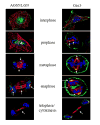Mechanistic pathways and biological roles for receptor-independent activators of G-protein signaling
- PMID: 17240454
- PMCID: PMC1978177
- DOI: 10.1016/j.pharmthera.2006.11.001
Mechanistic pathways and biological roles for receptor-independent activators of G-protein signaling
Abstract
Signal processing via heterotrimeric G-proteins in response to cell surface receptors is a central and much investigated aspect of how cells integrate cellular stimuli to produce coordinated biological responses. The system is a target of numerous therapeutic agents and plays an important role in adaptive processes of organs; aberrant processing of signals through these transducing systems is a component of various disease states. In addition to G-protein coupled receptor (GPCR)-mediated activation of G-protein signaling, nature has evolved creative ways to manipulate and utilize the Galphabetagamma heterotrimer or Galpha and Gbetagamma subunits independent of the cell surface receptor stimuli. In such situations, the G-protein subunits (Galpha and Gbetagamma) may actually be complexed with alternative binding partners independent of the typical heterotrimeric Galphabetagamma. Such regulatory accessory proteins include the family of regulator of G-protein signaling (RGS) proteins that accelerate the GTPase activity of Galpha and various entities that influence nucleotide binding properties and/or subunit interaction. The latter group of proteins includes receptor-independent activators of G-protein signaling (AGS) proteins that play surprising roles in signal processing. This review provides an overview of our current knowledge regarding AGS proteins. AGS proteins are indicative of a growing number of accessory proteins that influence signal propagation, facilitate cross talk between various types of signaling pathways, and provide a platform for diverse functions of both the heterotrimeric Galphabetagamma and the individual Galpha and Gbetagamma subunits.
Figures








References
-
- Adhikari A, Sprang SR. Thermodynamic characterization of the binding of activator of G protein signaling 3 (AGS3) and peptides derived from AGS3 with G alpha i1. J Biol Chem. 2003;278:51825–32. - PubMed
-
- Afshar K, Willard FS, Colombo K, Johnston CA, McCudden CR, Siderovski DP, Gonczy P. RIC-8 is required for GPR-1/2-dependent Galpha function during asymmetric division of C. elegans embryos. Cell. 2004;119:219–30. - PubMed
-
- Bellaiche Y, Gotta M. Heterotrimeric G proteins and regulation of size asymmetry during cell division. Curr Opin Cell Biol. 2005;17:658–63. - PubMed
-
- Bellaiche Y, Radovic A, Woods DF, Hough CD, Parmentier ML, O’Kane CJ, Bryant PJ, Schweisguth F. The Partner of Inscuteable/Discs-large complex is required to establish planar polarity during asymmetric cell division in Drosophila. Cell. 2001;106:355–66. - PubMed
Publication types
MeSH terms
Substances
Grants and funding
LinkOut - more resources
Full Text Sources

